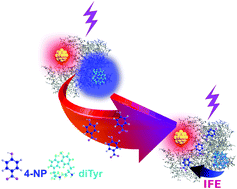Dual-emissive gold nanoclusters for label-free and separation-free ratiometric fluorescence sensing of 4-nitrophenol based on the inner filter effect†
Abstract
Highly sensitive detection of 4-nitrophenol (4-NP), one of the most hazardous and toxic phenols, has been highly sought-after. In this study, we found that 4-NP could selectively quench the 410 nm emission of the dityrosine (diTyr) residues of BSA-protected gold nanoclusters (GNCs@BSA) rather than the conventional red emission of GNCs@BSA via the inner filter effect (IFE). This finding helped us to develop a label-free and separation-free ratiometric fluorescence method for sensing of 4-NP with red emissive GNCs as the endogenous reference for the first time. This ratiometric sensor exhibited rapid response to 4-NP within 1 min. The photoluminescence (PL) intensity ratio of the 410 nm emission of the diTyr residues to the 630 nm emission of the GNCs (F410/F630) showed a linear relationship with 4-NP concentration in the range of 50 to 5000 nM (R2 = 0.991) with a limit of detection (LOD) (S/N = 3) of 13.8 nM (1.9 ng mL−1), remarkably lower than the concentration limit released by the US Environmental Protection Agency (EPA) for drinking water (60 ng mL−1). Also, the ratiometric sensor showed selectivity for 4-NP over other eight common phenol derivatives. Furthermore, the ratiometric sensor was applied to analyze the trace 4-NP spiked in the tap and river water samples and the satisfied results were acquired, showing promising potential of the ratiometric sensor for practical applications.



 Please wait while we load your content...
Please wait while we load your content...